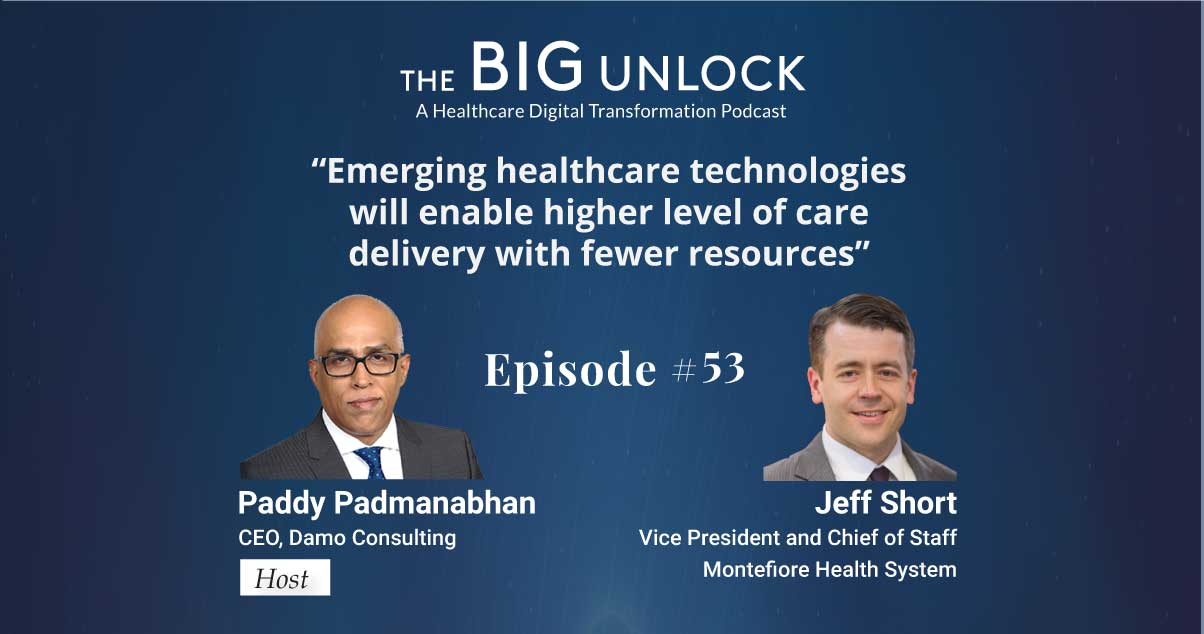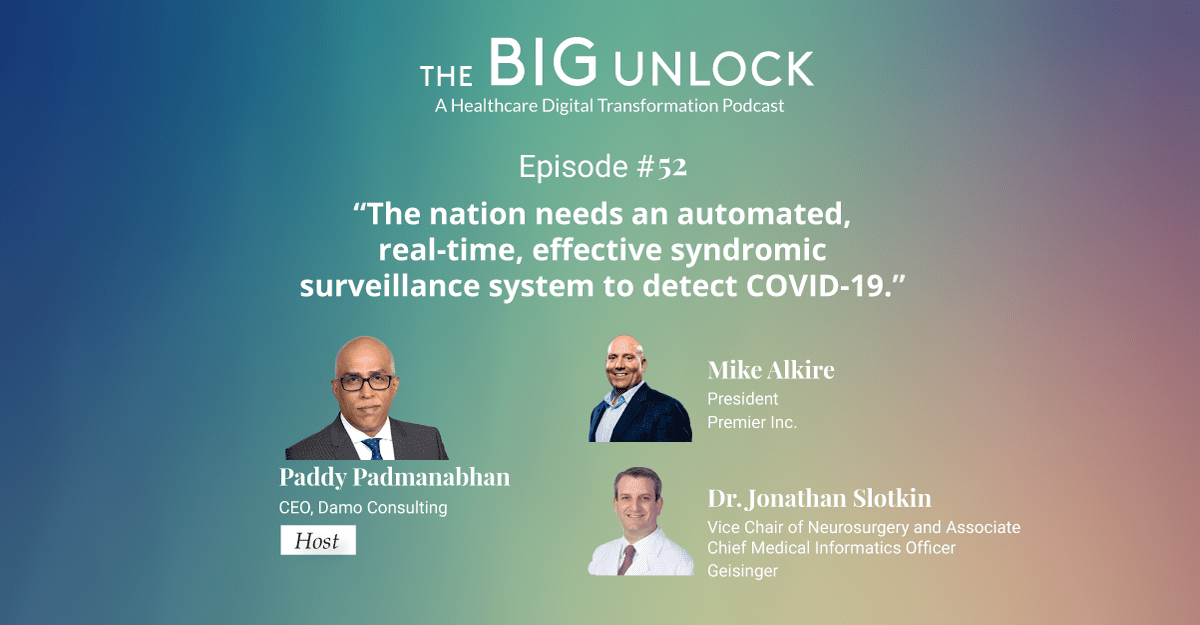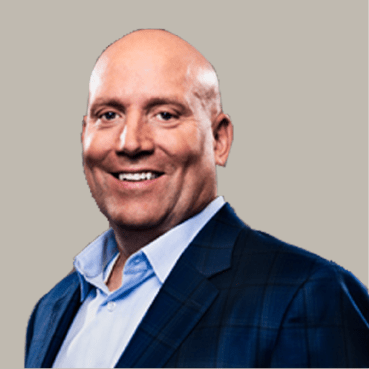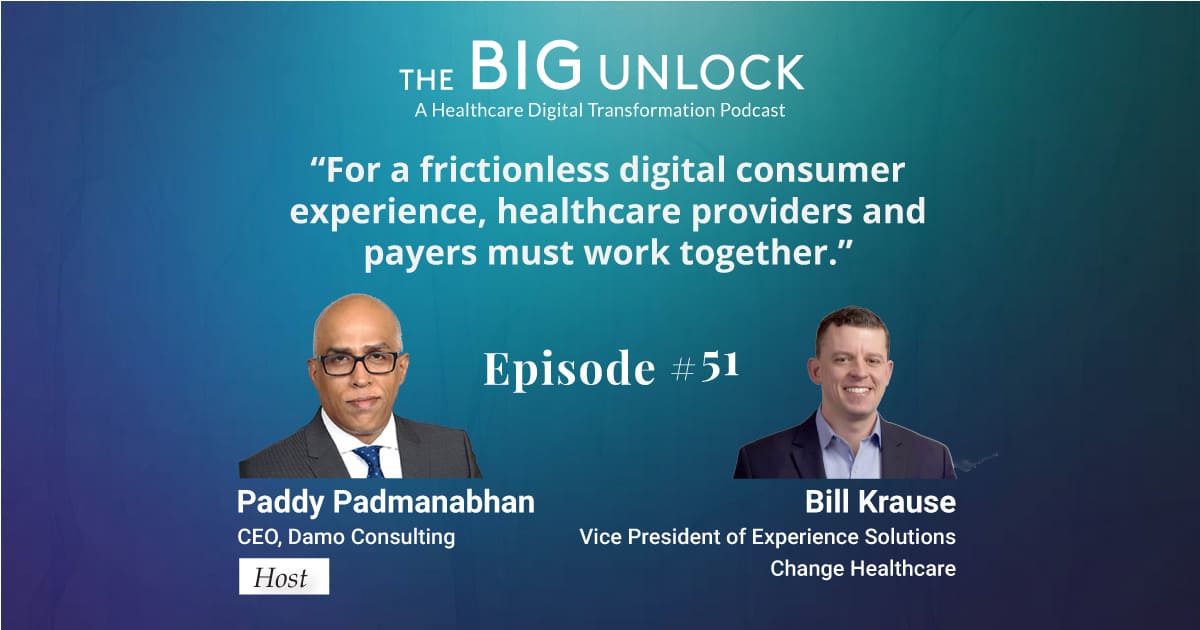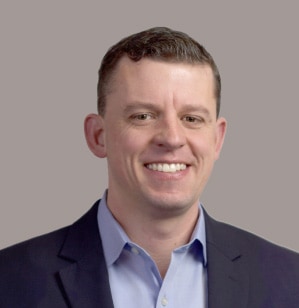Episode #53
Podcast with Jeff Short, Vice President and Chief of Staff, Montefiore Health System
"Emerging healthcare technologies will enable higher level of care delivery with fewer resources"
 Hosted by Paddy Padmanabhan
Hosted by Paddy Padmanabhan 
Share
In this episode, Jeff Short, Vice President and Chief of Staff at Montefiore Health System describes how Montefiore prepared for one of the biggest surges of COVID-19 cases in the country, and how they used emerging healthcare technologies to manage capacity and deal with the crisis.
By end of April this year, 80 percent of all patient visits in Montefiore were being managed through telemedicine. Telehealth visits volumes have fallen back a bit since then. Jeff believes that face-to-face visits in certain specialties will always remain essential, however, with the ease of working with patients digitally, we will continue to see an increase in telehealth visits. Jeff defines digital health as the use of technologies such as digital front doors and telemedicine to improve patient engagement and access to care delivery. He further states that once we get efficient at delivering digital care and leveraging emerging healthcare technologies like chatbots and AI, we will be able to treat more patients at a higher level of care with fewer resources.
Montefiore Health System is one of the leading medical centers with 11 hospitals and over 300 ambulatory locations. They mainly serve the populations in the Bronx and Westchester counties.
Jeff Short, Vice President and Chief of Staff, Montefiore Health System in conversation with Paddy Padmanabhan, CEO of Damo Consulting on the Big Unlock Podcast – “Emerging healthcare technologies will enable higher level of care delivery with fewer resources”
PP: Hello again, everyone and welcome back to my podcast. This is Paddy, and it is my great privilege and honor to introduce my special guest today Jeff Short, President and Chief of Staff of Montefiore Health System in New York. Jeff, thank you so much for setting aside the time and welcome to the show.
JS: Thank you, Paddy. I really appreciate the opportunity to be here. I want to congratulate, as you recently completed your fiftieth podcast. So, congratulations! That’s really a great milestone and I’m also looking forward to reading your new book, Healthcare Digital Transformation. It’s where we are, so I can’t wait!
PP: Thank you. I greatly appreciate that. So, Jeff tell us a bit about Montefiore and the patient populations you serve.
JS: As you mentioned, we’re in New York. Montefiore Health System and Einstein College of Medicine form one of the nation’s leading academic medical centers. We have 11 hospitals, approximately 3000 beds, and over 300 ambulatory locations. We serve mainly the populations in the Bronx and Westchester counties. We are major employers in both geographies, we serve a diverse population both ethnically and socially. And it’s been an incredible experience working with Montefiore and seeing all the good that we do in the communities that we serve.
PP: If I’m not mistaken, you also serve possibly one of the most ethnically and linguistically diverse populations in the country, if not the most diverse population. Is that correct?
JS: Yeah, depending on how you measure it. But definitely one of the most diverse populations in the country.
PP: New York has been one of the hardest hits by the pandemic, and Montefiore was featured in this fascinating TV program on CBS. Those who haven’t seen it, I strongly recommend it. It’s called ‘Bravery and Hope’, which took viewers like me to the frontlines of the COVID-19 crisis and was an eye-opener to see what really happened in the frontlines of a crisis like this. So, Jeff I know that Montefiore stood up telehealth operation practically overnight. Can you tell us a little bit about that experience?
JS: CBS did an incredible job of capturing what it was like during the surge of the pandemic. In the days prior, we spent a lot of time preparing. One of the things our network performance group did was to regularly update predictive models based on what was going on in Italy and around the world and in New York. When we looked at the numbers, we realized it was not going to be a linear increase. It was going to be an exponential increase. I remember one day looking at those projections and realizing that we could be out of capacity in a few days and out of our surgeapacity a few days after that. It really hit home how we needed to change. We knew we were going to have a wave of patients coming, we didn’t have steep, but it looked pretty daunting. Our facilities team did a great job by extending capacity. We put new rooms in our ORs, cafeterias, auditoriums. We redeployed a lot of our clinical staff. But the real question was, how are we going to leverage our intensivists to treat all those patients. We knew we’re going to need that level of care. One of the people featured in that video, Dr. Michelle Gong, who is our Chief of Critical Care, worked with our team and with IT and bioengineering. In a span of a few days, the team stood up a 24/7 ICU command center. My team put together a new server to feed healthcare information and healthcare records to a central location – Bioengineering linked, real-time, vital signs, ultrasound results, electrocardiograms. To all the physicians in our ICU command center, we gave iPads out to each unit. This way they could do bidirectional communications by the command center. So, when we were done, essentially what happened was a clinician anywhere in the facility could connect with one of our critical care pulmonology specialists in the command center for assistance with the patient. In a span of mere days, we went from nothing to a fully functional ICU command center, that really helped us deal with the surge capacity.
PP: That is an incredible story. What about the patients? What about those who wanted to either come in because they felt they had symptoms or others that were in your care, like the chronic population and so on, because you obviously locked down the entire facility for a period of time like everyone else did in order to deal with the COVID-19 cases. Did you already have or were you able to turn on a telehealth/ virtual concept kind of capability to help your patients?
JS: Yes, absolutely. In the early days, no one wanted to go see the doctor for elective care. Nationally, over 70 percent of in-person visits were canceled and we saw the same experience here. Lucky for us, the CMS approved 80 new services within a few weeks of the pandemic hitting the US, which was really fantastic. But what we needed to do is create a new solution. So in about a week, March 11th was our first patient, we started to get things in place to create the ability to deliver contactless care to our patients. By March 26, our team built the infrastructure to enable us an Epic to schedule document and bill for a telemedicine visit. We identified our partners to help us build a platform and an app. By April 1, we had launched what we call Montefiore First, which is an app platform that is in Android and the Apple store. And by June, it was among top 100 medical download on the Apple store. So, by the end of April, 80 percent of our visits were in telemedicine. Right now, it is shifting back a bit. But in the last 12 weeks, we have had 250000 telemedicine visits. In February, we had zero. We went from zero to doing most of our visits in telemedicine quite quickly. And, we’re really not alone, across the industry, we have seen 50 times to 150 times increase in telemedicine.
PP: I want to go back to one comment you made very briefly, that is you’re seeing telehealth visits kind of fall back a little bit. We know that the acceleration of telehealth and specifically virtual consults and everything took off in the immediate wake of the pandemic. But I am hearing from across the board that those volumes are now kind of going down a little bit, either because patients are coming back into the hospital or because there is not that much need. What is driving that? Why do you think telehealth is going down? Was it because pent up demand for in-person visits is now coming back? Or are people not happy with Telehealth as an alternative? What do you think is the reason?
JS: I think it is in part of patients that needed to be seen face-to-face. We’re putting off care. So, they’re definitely rushing back in. I think for certain clinicians and certain patients, there’s a comfort level with face-to-face. But I do really think that things have changed permanently, and the change is here to stay. Before the pandemic, a survey done by McKinsey stated, 11 percent of patients were interested in telemedicine, post-pandemic 76 percent, the same survey updated. We’re interested in using it going forward. We will always have face-to-face care and certain specialties will remain that way. But as we get better and more comfortable working digitally or remotely with patients, those numbers will continue to increase. Also, as adopters become more comfortable, as technology providers create more in-home devices that are linked through your smartphone and operate effectively, we’ll be able to do a lot more remotely. But I do believe it’s here to stay.
PP: You mentioned digital, digital health is all the rage now. We talked about telehealth, digital front doors, and just virtual care in general, which is enabled by technology. How are you defining digital at Montefiore and what has been your digital transformation journey so far? Can you share some of that?
JS: Digital health can encompass a lot of things. For me, in this context, it’s basically using technology to enhance the quality of access or the delivery of care. But to be more specific, the general areas that we’re looking at our digital front doors using technology are to improve patient engagement, to enable contactless interaction to increase access, the use of telemedicine, which we just spoke about. It has profound opportunities to reduce the cycle times of care. With remote monitoring, there’s so much we can do that you don’t need to come back in just to monitor condition if we can check in with you remotely through technology. In tele-consult, the ICU example creates incredible ability to keep patients in a regional hospital, a local hospital and deliver top level of care remotely. Artificial intelligence: Dr. Parsa Mirhaji in our team has made incredible strides in using artificial intelligence to predict things like respiratory failure. What we see is that opportunity to use AI in many more ways and build those into systems. We stood up a chatbot to answer COVID-19 questions. We see a lot of new startups using that technology in front of visits to help the patient and the clinician get to the root of the problem and also improve their interaction. We see huge opportunities to leverage AI. And then the same deal with inpatient. So, hospitals around the country are looking at doing central stations, whether there is AI and other technology to better run their hospitals. And we see this as a huge opportunity. We’ve made a ton of progress in a short amount of time, especially on telemedicine, digital front doors, and also some of the remote monitoring on the inpatient side. We really have a long way to go. But it’s very exciting.
PP: You’ve covered most of the high value, high impact initiatives. And the focus areas you talked about remote monitoring, digital front door, which is growing as digital engagement touchpoints become more and more amenable to digital engagement, online tools and so on and so forth. And, of course, telemedicine and virtual care. How do the patients perceive it? One of the things that I hear from all the health systems and the Chief Digital Officers and everyone that I talk to is that it’s extremely challenging to create the kind of seamless experience that we are used to, like e-commerce Amazon or your personal banking site. It is very difficult to create that kind of experience in healthcare. It seems to me that there’s a lot of standalone best in class type tools. Then there’s a dominant EHR system in the background that does a lot of things, stitching it all together and creating those experience journeys which feel seamless and can delight patients just from an experience standpoint that seems extremely challenging. Is that consistent with your understanding of the challenge as well? What are you seeing in terms of how patients are reacting and responding to your digital front door initiatives, for instance?
JS: Telemedicine has struggled for years to really get adoption. COVID-19 has changed the landscape through which now clinicians and patients were encouraged or forced or compelled to give it a try. Obviously, the ultimate goal is to have that seamless experience. But it’s something we’ve been working on in healthcare and made a lot of improvements over the last few years. I think it is somewhat like when I traveled a lot and the first time I encountered an airline kiosk, when I arrived at the airport, I was really unhappy with the change, not being able to deal with the person, but probably the second time I never really wanted to interact with an agent again unless I had a major, complex problem that I needed to deal with. As long as we continue to seek out clinician and patient feedback and very closely monitor where the pain points are and where our opportunities are to improve and build those in very quickly adapting to the patient experience, but also meeting the patient where they are. So, whether you want to do an asynchronous visit, a synchronous video visit, or you want to see a physician face-to-face, it’s really seamless. And if you want to speak to someone on the phone or go at 2:00 in the morning, do something on your cell phone or your laptop, no matter what we’re meeting the patients where they are and like you said, giving them a seamless experience. It’s just going to be like any other customer experience. It is really going to be listening very closely and getting good data on how patients feel. And again, just iterating to make things more seamless and more effective.
PP: You mentioned a couple of examples of digital initiatives that you’ve launched, chatbot, for instance. Have you done any research into what your patient populations value or what your own caregiver’s value and need? When you look at the digital engagement opportunities, can you talk about one or two of those that you think have high impact possibilities in the short term?
JS: Sure. We’ve done a number of surveys, interviews. We have active working groups that get together every week and walk through their experiences and their problems. We’re adding on to our application ways to get customer and clinician feedback at the moment to better understand their experience. When we look back at our priorities, telemedicine has drastically changed the way we deliver ambulatory care and that is just a key opportunity. We are able to actually bring care into the patient’s homes at scale effectively and efficiently. The digital front door, the ability to gain access from wherever you are to a clinician in a smart way is top of the list. I believe that on the inpatient side, telemonitoring, tele-ICU is a better way to deliver care. And we experienced that during the pandemic and the surge.
PP: You also mentioned contactless experience, which I think is a new beast that we have discovered as a result of the pandemic. But what about your patient population? You are in New York, part of your operations is in the Bronx area, which is kind of a low-income area in the least in some parts. Does your patient population have certain preferences? Do you think you need to tailor your strategy, keeping in mind what are the limitations that maybe with your patient populations, or do you think that is not a factor at this time?
JS: It’s an absolute factor. I mean, the access to and comfort level with cell phones or computers is definitely something we’re looking at. And where there may be disparities in how we can actually address that. Also, access to data that seems to have been an area where patients are concerned about data charges. We’re figuring out other ways we can improve access. Living in a city this could be a great infrastructure type project to provide broadband access to patients for healthcare and could be an absolutely incredible opportunity. We realized little things that people not wanting to download apps. Are there ways we can get them broadband access, even just comfort level using a mobile phone for this purpose? And we’re kind of combining all these things to really create different options and then monitor which options are most successful. And then doubling down in those areas. We’re expecting it’s going to be different by different groups, different age groups, different specialties. And we’re just going to keep listening and looking for opportunities to improve.
PP: The digital divide that you talked about. This an interesting point, because clearly not all sections of the population have the same access to bandwidth or the affordability aspect of it as well. In Chicago where I live, there’s a public-private kind of collaboration that is emerging where there’s going to be a program to make sure that the coverage of the entire population in terms of their access to broadband is going to be uniform. So that there’s no digital divide, there’s no sort of disparity. Are you seeing anything like that emerging in New York? During the pandemic itself, there was a lot of public-private collaboration. Can you talk a little bit about that? I think it’s an interesting trend that is emerging. What your experience has been collaborating with local authorities.
JS: Absolutely, it was really one of the incredible things to see. From the start, the governor’s office essentially stated that we are one healthcare system, they really lined up everything essentially around the same goal, which was the surge that we were going to see, that did a pretty good job of predicting how things were going to play out in the early months. That spirit of collaboration really ran through a lot of things that we worked on. We worked with local vendors, we worked with other hospitals, it was really incredible to share the knowledge and ideas. And we were on the phone with colleagues understanding and sharing best practices, sharing how we’re working together. So, that spirit of collaboration continues. It was always there somewhat in academic medicine, but it’s kind of expanded more to people caring for their communities and can be defined in a number of different ways. We’ve got a couple of discussions going on with companies really trying to bridge that digital divide, because there’s so much evidence out there that does exist. And it is an equalizer that if we can bridge that gap, we can do a lot of good and create a lot of value, not just in healthcare, but also in education, etc. I’m hoping that’s an area where we can really collaborate and do public-private partnerships in order to create a lot of value.
PP: Everything in healthcare is linked to reimbursements in some way. And you did make reference to the fact that the CMS has brought telehealth visits on par with in-person visits. There are still some gaps in the reimbursement model. The broader question is, all these investments that you talked about, the digital front, the tele-ICUs and all of that have to be paid for in some way, shape, or form. So, you have to demonstrate some kind of ROI. How does a health system approach this typically, especially if you are predominantly in a fee-for-service kind of a model?
JS: It’s one of those things we’ve always struggled with as an industry and some of those unintended consequences of how incentives are structured. I guess where we start with is really what’s right and best for the patient. And then we figure out what options we have. The nice thing about our size and our scale is we have a couple of ways economically to get to create value for the business model. So sometimes because it’s the right or efficient way to use resources, it may take a haircut on revenue. But try and take a step back and look at the whole picture. What kind of value we can curate for our patients? Where are these gaps and maybe how the incentives are structured? And then what can we do to kind of either countermeasure to deal with those gaps, work on waivers, try to be creative in trying to deal with those gaps. But it’s something we’re constantly working on, constantly looking for new ideas and new innovations to address those gaps. I think ultimately around the reimbursement for digital health needs to be about equity and payment. I think once we get much better and efficient and effective at delivering digital care, we’re going to find ways to leverage technology like chat technology and AI and be able to treat more patients at a higher level of care with fewer resources. I think at some point what we want is our payment models to recognize that and balance that. So, yeah, and that’s why that’s one equity, I think is really what we want to get to and try and get away from the gaps that we have that cause some of the barriers to innovation and to delivering care.
PP: There’s a saying that never waste a crisis and we are going through an unprecedented crisis because of the pandemic. Are you seeing COVID-19 as an opportunity or as a long-term threat for your system?
JS: I think it’s both. It’s a tremendous threat. I mean, we had a tremendous loss of life. We had employees, colleagues who passed away from this awful disease. Our industry has taken a real hit. The local economy and national economy have taken a tremendous hit. But all those things are done. So within that, there’s an incredible opportunity to do better. To accelerate change, to challenge the status quo. I mean, look at all the things that we have been able to really make progress in the industry. We’ve made so many improvements and we’ve had so much innovation last few months. We have to take advantage of this crisis. We’ve paid the price; might as well take advantage of the opportunity to really accelerate the innovation in healthcare and really bring it forward. So, the answer is it’s both, unfortunately.
PP: Jeff, it’s been such a pleasure speaking with you. Thank you so much for sharing your thoughts and look forward to following all your progress and all the best with your digital transformation program.
JS: It’s been great speaking with you and I look forward to catching up soon.
We hope you enjoyed this podcast. Subscribe to our podcast series at www.thebigunlock.com and write to us at info@thebigunlock.com
Disclaimer: This Q&A has been derived from the podcast transcript and has been edited for readability and clarity
About our guest

Jeffrey B. Short is Vice President, Chief of Staff of Montefiore Health System and the leader of Montefiore’s Faculty Practice Group. Montefiore is one of the leading academic health systems in the country with 11 hospitals, 300 ambulatory locations, 35,000 employees and 6 million unique patient encounters. Montefiore’s Faculty Practice Group is one of the largest in the country with over 1500 physicians.
Jeff received his BS in Accounting from the University of Scranton, and his MBA from the NYU Stern School of Business. He came to Montefiore from NYU Langone Medical Center, where he served as the Department Head for Strategy and Business Development. Earlier, Jeff worked as a management consultant for 13 years with both Deloitte and PricewaterhouseCoopers. At PwC, Jeff was a Director and regional leader in the strategy and enterprise growth practice, working with clients such as the Cleveland Clinic and John Hopkins Medicine. He also spent 3 years in Europe leading business development and healthcare engagements with clients in the Middle East and Europe.
Recent Episodes
About the host
Paddy is the co-author of Healthcare Digital Transformation – How Consumerism, Technology and Pandemic are Accelerating the Future (Taylor & Francis, Aug 2020), along with Edward W. Marx. Paddy is also the author of the best-selling book The Big Unlock – Harnessing Data and Growing Digital Health Businesses in a Value-based Care Era (Archway Publishing, 2017). He is the host of the highly subscribed The Big Unlock podcast on digital transformation in healthcare featuring C-level executives from the healthcare and technology sectors. He is widely published and has a by-lined column in CIO Magazine and other respected industry publications.
